Now pouring at Lonsdale Street Roasters:
1. Johnny Cash
2. “The One”
3. P.N.G.
My son Ben is at the controls.
Here’s to Tuesday: my free day.
*

A quiet place.
From time to time a fairy ring grows beneath my Spruce fir tree. At the moment it’s not a whole circle but more of a semi-circular meandering of mushrooms across the lawn. It’s been growing for about a week and must be following a long root of this tall tree.
On Sunday I noticed one particular mushroom coming up in the nearby garden about five metres from the beginning of the line. It’s like a pop-up house for little people, and evokes Faerie, that land of enchantments and enchanted beings.
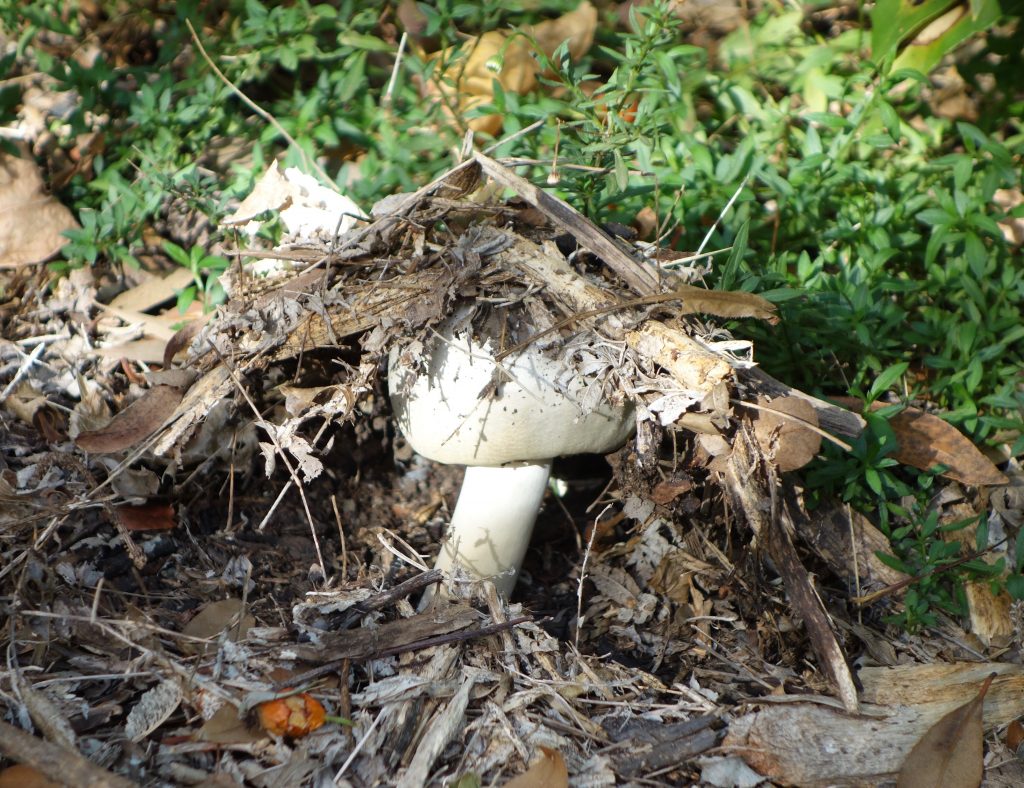
It’s expanding as it ages, yet the leaf-litter roof is still in place.
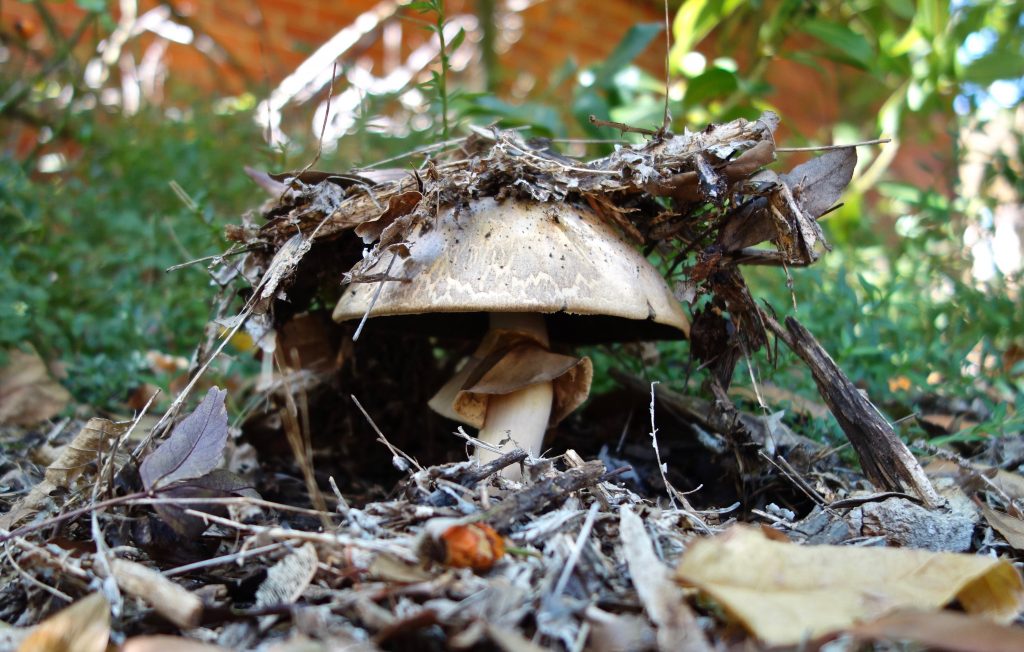
The small shelter over the mushroom makes it easy to understand why children could believe there are tiny fairy-folk residing within.
But recently I learnt that not only children have believed in fairies! Writers of Faerie in the 19th century (about 90% of whom were men) expressed a fearful respect for the little winged women, often passing a mention in their tales that fairy love was fatal to men. Male authors were wary of a fairy for she could transform or disguise herself. Small as she was, she could be mistaken for an insect or a bird, she could even become invisible, and, most dangerously, she could turn herself into a real woman. But the rule was that no man could love her and live.
I’ve read a lot of French fairy tales and have found it to be true. In Théodore de Banville’s story “La Chiffonnière”, for example, a fairy becomes an old ragpicker who is almost trampled by horses, but a kind-hearted poet picks her up where she falls, and in his arms she is rejuvenated, now young and beautiful. Though she wants to give him her love as a reward for saving her life, she knows it would kill him. Instead she offers him the finest cigar in the world, and four wishes.
Fairy rings are also things to beware of, to tread carefully around and not through. Men who entered the ring often disappeared and those who were tempted needed to be rescued. It seems the ancient curse has exhausted its power, for I’ve often stepped into mushroom rings in my lawn but have never disappeared…
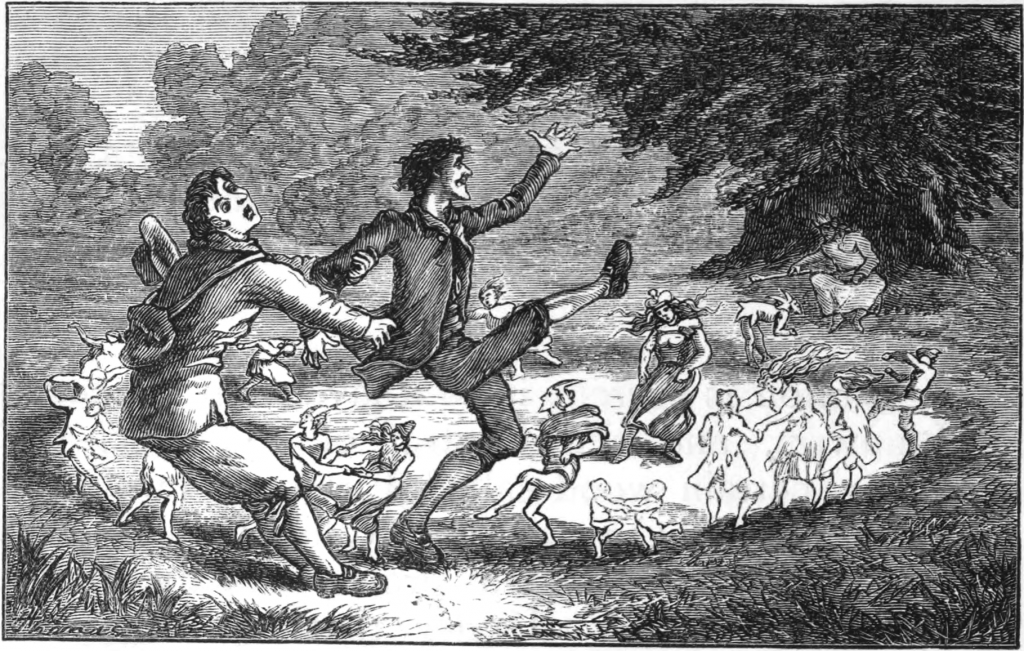
While I know these fairies are not really magical, I also know that, in my garden, suddenly emerging fungi certainly are.
*

I stumbled on a reading challenge by my local ACT library this week, and at first I dismissed it as I do with challenges generally. But the list of categories looked manageable for what remains of 2019 and the thought occurred to me that I could tick them off, no worries. It came to me a few days after I found a new library in the small Australian Catholic University around the corner from me that has a very welcoming wall at the entrance. Here it is. Zoom in (click and click again) to read students’ stick-it notes…
Here I picked up a book I’d always avoided for no good reason, The Magic Pudding by Norman Lindsay, an early Australian classic, which fits one of the categories of the challenge, ‘Something you regret not having read yet’.
And then this morning, I cast my eye quickly over the pop-up library outside a local café. Zoom in to see what sort of books Canberrans read…
There on the shelf was a book that someone once highly recommended, The Kite Runner by Khaled Hosseini. I’ve brought it home, except now I remember having read it, but it fits another challenge category, ‘Something you want to re-read’.
That’s two. But I have a third book that fits the category ‘Set in an imaginary world’: Contes féeriques (Faeric Tales) by Théodore de Banville. The title page is illustrated by Georges Rochegrosse, his stepson. Note the age spots, it’s an old one. Zoom in to see the fairies floating around the amorous couple…
Banville wittily gives it the subtitle ‘Scenes from Life’, but every tale revolves around the intervention of a fairy, magician or other supernatural figure! I recently had a translated story published that comes from this collection, ‘The Lydian’ which you can read for free if you click the link, and if you click here you can read more about it. But I haven’t yet read every story in the book, so it’s going on my challenge list.
That’s three, and only seventeen more to find to tick off everything on the challenge list. It should take my reading to the end of this year:
2019 Libraries ACT Reading Challenge
*
I recently had a bathroom renovated and had to remove this sign which had been stuck to its wall for years. (I don’t live near the sea.)

I haven’t put it on the new wall, so now it sits abandoned in a bedroom where I read it every time I walk past. I’ve never stopped believing what it says.
In recent months I’ve spent time on the beautiful beaches of New South Wales, and just this last weekend as I walked the length of Lilli Pilli beach, I thought of my sign and realised that it was true, all my pitiful thoughts were washing out with the waves.
There were rewards even for resting my eyes on the water in this shallow bay of Lilli Pilli Beach where the sea near the shore is turquoise.
By the sea, natural beauty fills my head and heart to the brim. There’s no room for anything negative, only praise. Just look at these three tubes protruding from the sand. I know little about them but a search leads me to believe they were built by worms. Amazing, fragile structures.
Further up the coast is Kiama and the Devil’s Blowhole, a gap in the cliff rocks where waves come rushing into a cave below and shoot up through the hole like a fountain. The spout has taken a few lives over the centuries, but today a fence ensures that as long as I stay behind it, my worries will be washed away but I won’t!
Even when the sea is not turquoise or even blue, it can still have a unique beauty. This steel grey rock pool at Coledale in Woollongong, the biggest rock pool I’ve ever seen, reflects the expanse of grey clouds in its smooth grey surface and takes my breath away. One old man was swimming in the sea baths while I was there. It wasn’t a warm day. But he had the whole baths, this whole part of the ocean, to himself.
While we all leave our footprints on the beach – the loneliest stroller is aware of all those who strolled before her – sometimes humans can leave behind something admirable. Like wandering minstrels, wandering artists can enhance nature, and out of the kindness of their hearts make a sand sculpture, a piece of public art, temporal as it will be. I passed this crocodile at the water’s edge in Port Stephens late one afternoon and felt very lucky to catch it before the incoming tide broke it up completely.
But the best moments are when I see real creatures on the beach. On a shore near the old Nelson Bay lighthouse (now the Inner Light Tea Rooms!) these pelicans and seagulls made my day with their sleepy poses and big doll eyes.
Back in the city, far from the sea, all I have left is my sign to remind me that worry is inevitable but relief can be had if I can get to a beach. (The nearest one is just two hours’ drive away…)
*
It’s presently the fourth day of 40+ degrees celsius outside and 30+ in my house and I’m too weary to translate stories, a task that requires a cool unflustered mind. But I can show you what it’s like at my place in this heatwave where even the birds and bees are too hot to fly…
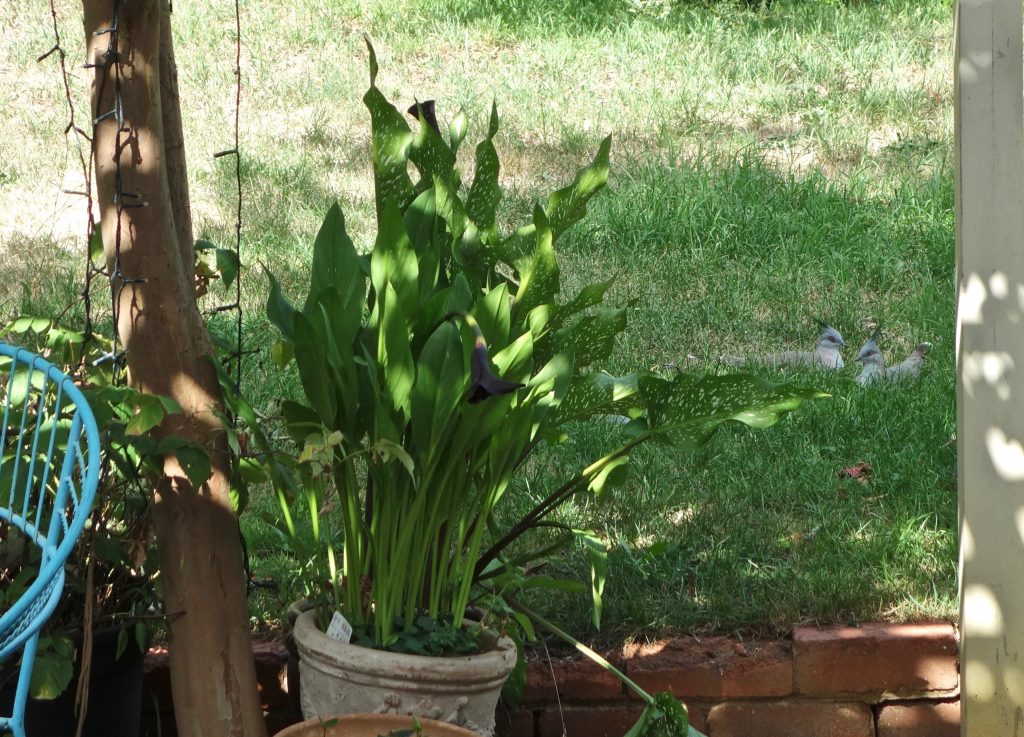
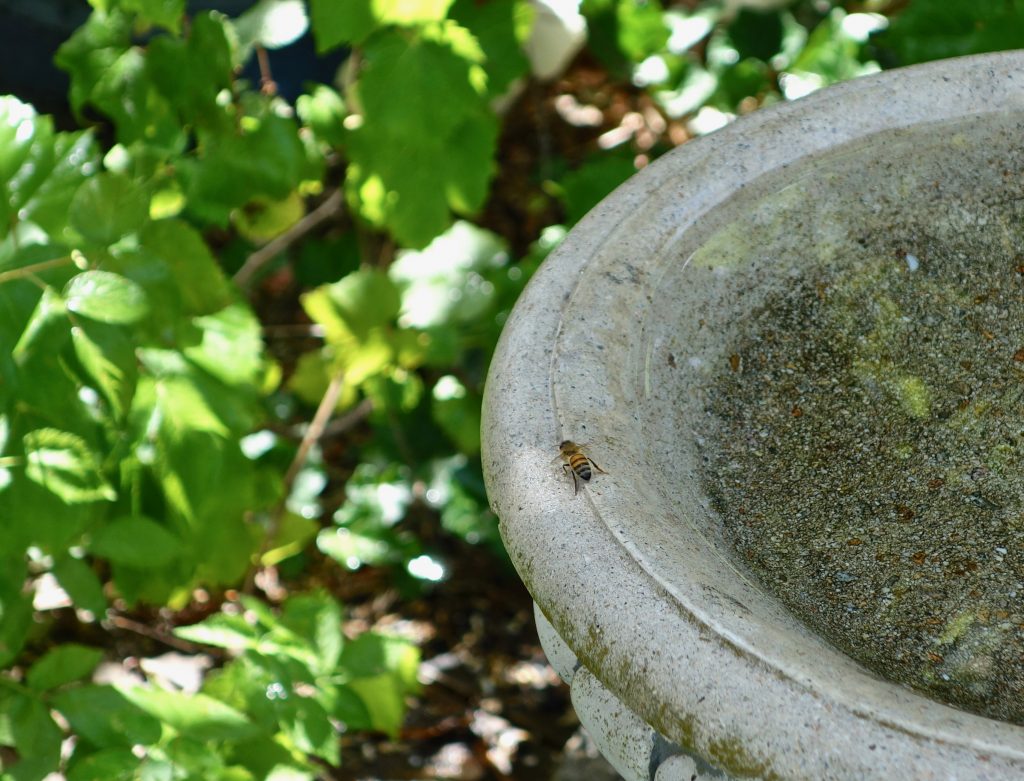
As the temperature climbed this afternoon, I started to melt, and turned the fan on without a thought for the consequences. I might as well have cast my neatly stacked, unbound manuscript to the wind…
Too hot and bothered to face this papery mess, I retreated to the kitchen to find something cold. The fridge is a friend on days like these, and as I opened its door, the freezer offered up a consoling box of Weis bars that I’d bought to take me back to my Queensland childhood.
While the disorderly manuscript was waiting on the floor for me to cool down, the ever-turning fan blew even more pages down onto the pile. I picked it all up and dumped it on the lounge, to deal with in the cool of the evening (which this week has been about 3am). Fortunately the pages are numbered, a trick I once learnt after dropping a longish story, its pages loose and unnumbered.
It’s now 7.30, the light is failing, it’s 30 degrees out and 30 in. My house holds its heat, a desirable eco feature in winter but not in a summer heatwave. An hour ago the sky clouded over, and out of it some pathetic rain drops fell for a few minutes and stopped.
Sigh.
*
This is my last post for the year.
It’s a hot Christmas week here in Canberra, and to defeat the heat we’ve been for a couple of walks where trees are green and water is present if not plentiful.
Late in the afternoon we went to Dickson Wetlands where the water level was way down and was even a wee bit stagnant in places, but was as still as a millpond and good for reflecting (lol) on Christmas and the year that’s coming to a close.
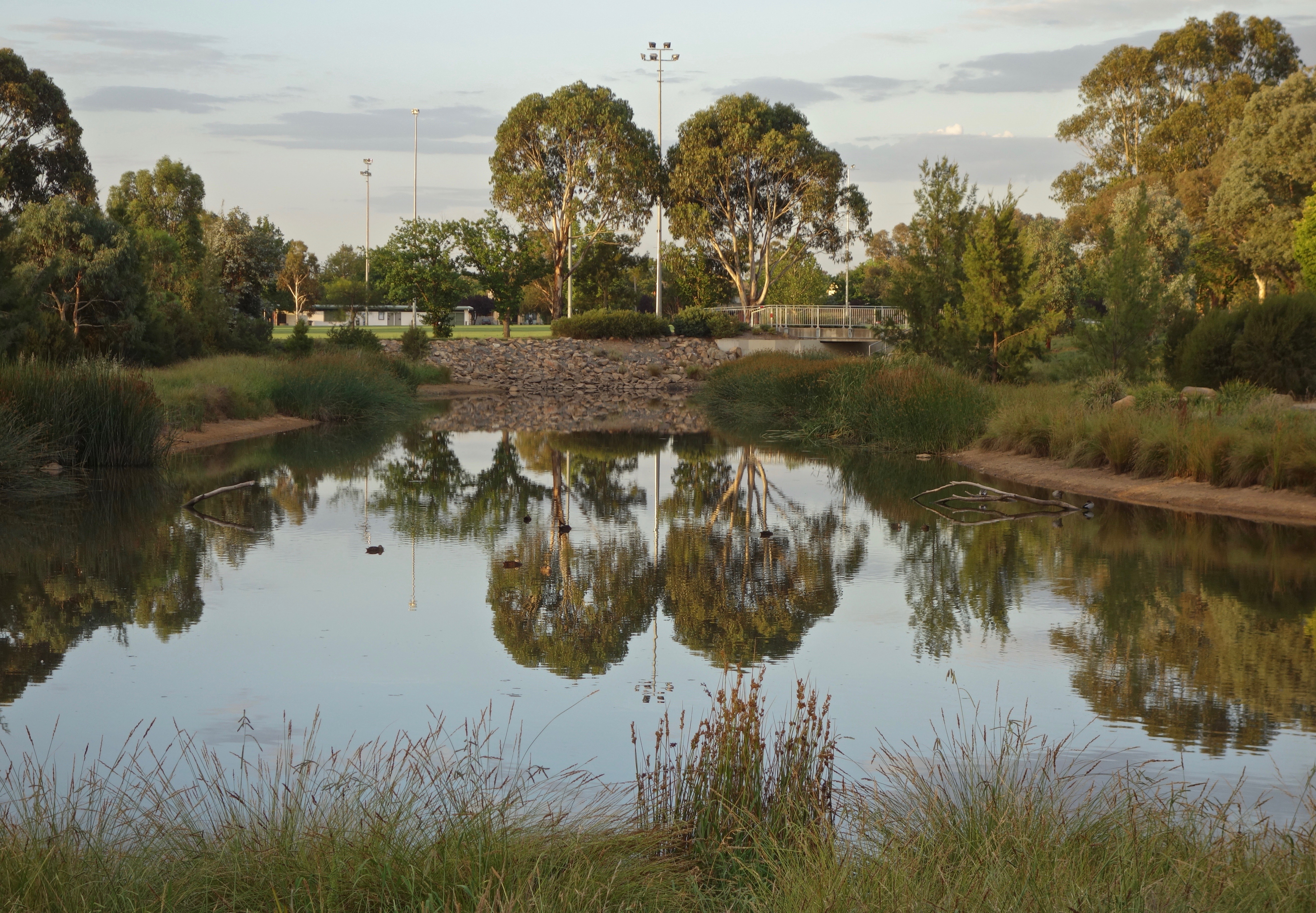
As I flitted here and there photographing whatever turned my head, my husband sat on a rock and read War and Peace on his phone. He’s 22% of the way through it after several weeks, but clearly it’s more compelling than the wetlands.
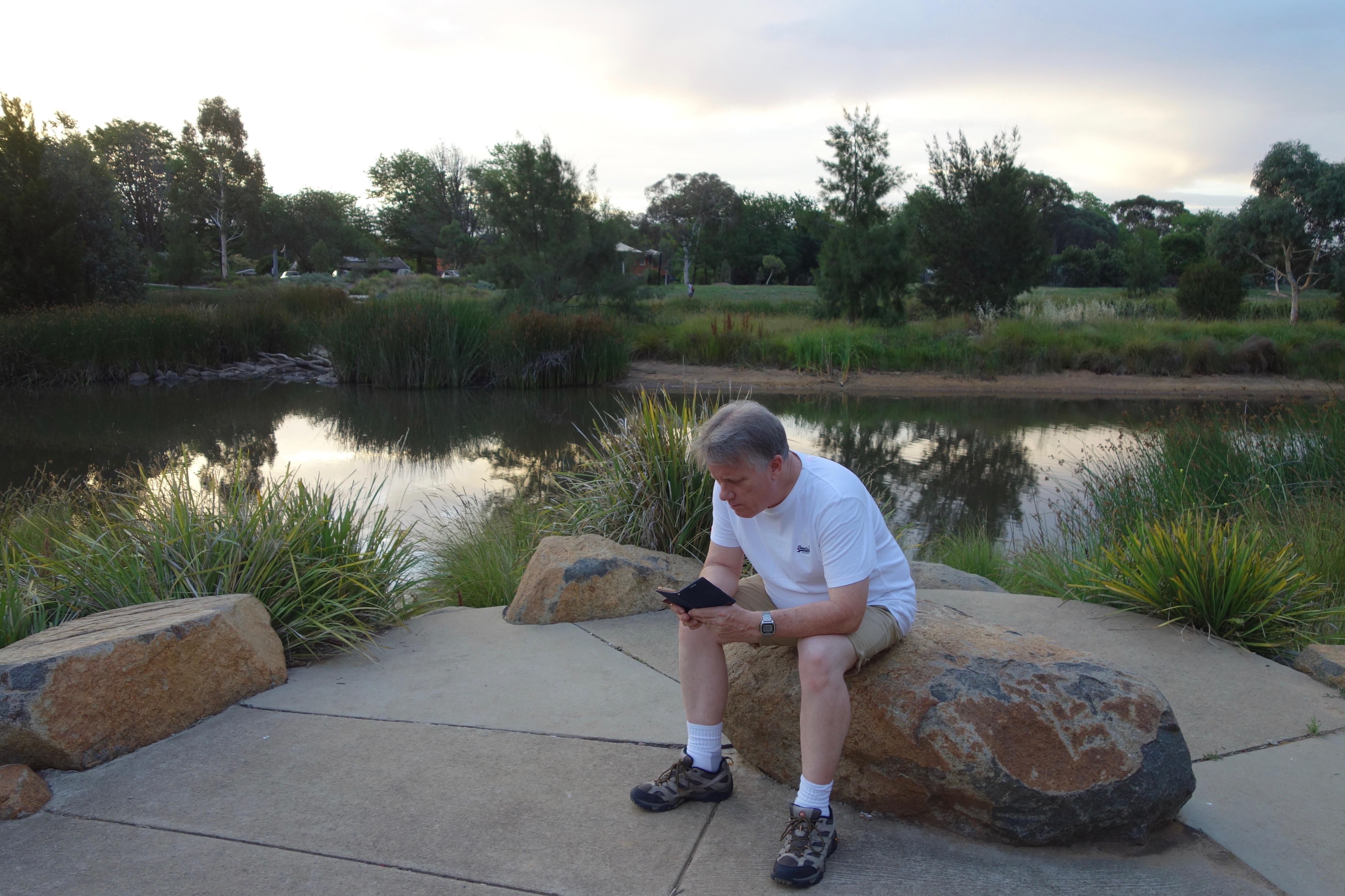
Then this morning we went to the Botanic Gardens to walk in its cool rainforest (a great creation in a city where it doesn’t often rain). Water dragons were basking on the bitumen at the top of the stairs leading down into the tropical zone. They’re patient lizards, happy to be photographed.
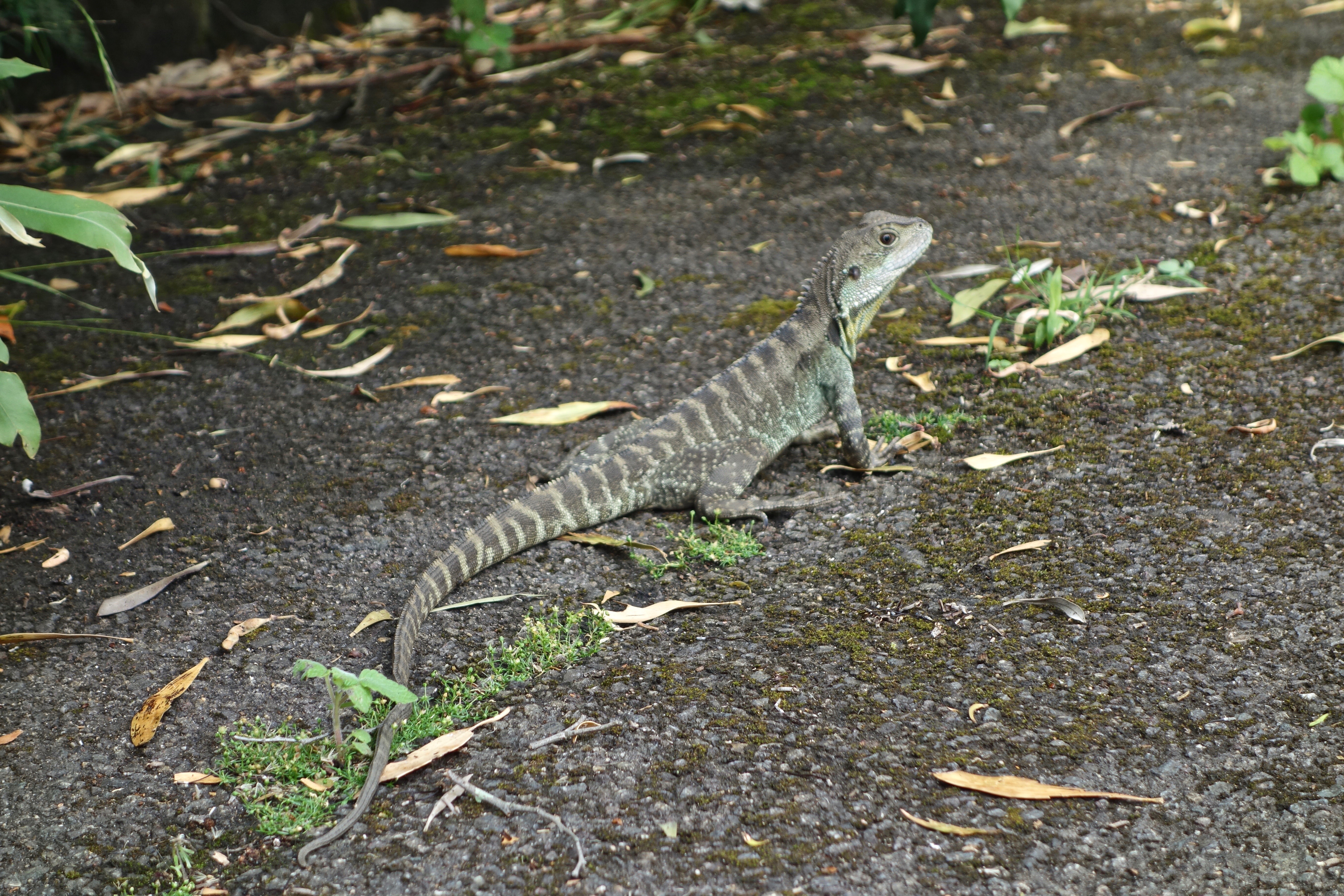
As I turned to descend the stairs I hesitated. This was all I could see:
The mist was thick and white as a cloud, thanks to the misting system that makes a normally dry forest wet. I feared going forward, though my husband promised me I wouldn’t fall. How cool it was! Many degrees lower than up on the road. The lizard didn’t know what he was missing.
The stuff of fantasies was everywhere on the forest floor. I passed this moss-covered fern-tree stump just as the sun broke through the canopy and lit it up.
But all is not fairy tale magic in the forest. Just when we were really enjoying ourselves we came across the snake warning and turned back – a snake can spoil a good walk. Brown snakes, one of the reptiles commonly seen in these Gardens, apparently eat the water dragons. And the dragons eat the frogs. That’s why there’s no photo of a frog.
But water dragons can elude snakes and that’s why I found this lovely lizard waiting for us when we ascended the stairs.
***
When I began blogging seven years ago, I loved showing WW2 photos from my father’s collection, many of them unique, surprising, moving, even amusing. I’ve just stumbled on a few that I think I blogged about and then deleted for some obscure reason that I no longer remember. Here’s one that suits my mood today with its large pond of water set in a peaceful Cairo public garden where palm fronds frame a white swan and a black duck swimming peacefully, ignorant of the war.
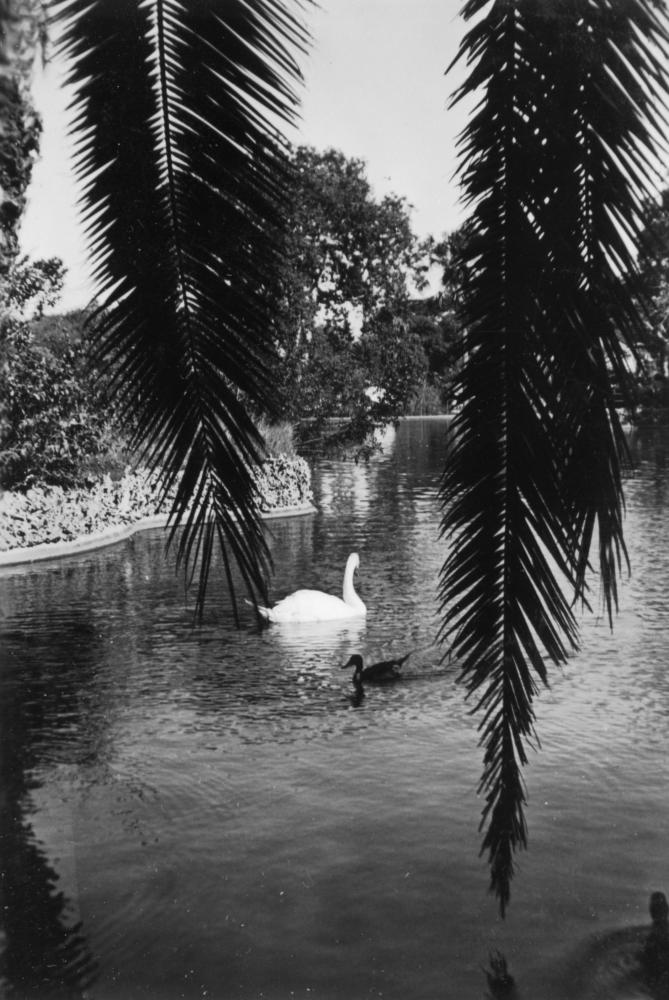
Happy New Year to all my readers. In 2019, may you stay cool when it’s hot and warm when it’s not.
***
On Wednesday the weather put a dampener on my holiday, bringing ceaseless heavy rain that made it impossible for me to see a particularly interesting sight, the SeaCliff Bridge in Wollongong.
On Thursday the rain eased enough for me to try again. But shortly after walking onto the bridge and taking a photo or two, the rain came down again and I scampered.
Today is Friday and the sun is shining. Now I’m in Sydney, still in search of sights I’ve never seen. My host recommended I go to Palm Beach Bible Garden for a magnificent view of the land and sea, and an exploration of a unique garden. The garden and its view were generously donated to the public in 2006 by the trustees of Gerald Hercules Robinson who established it back in 1966.
Everyone else in this street has a similar view of Palm Beach and the isthmus joining it to Barrenjoey Headland, but they (probably) purchased theirs for multiples of millions of dollars. This is a place of affluence. Thanks to Mr Robinson, we the ordinary public can enjoy it for free, and in peace.
The concept of this garden is to grow only plants mentioned in the Bible. Every plant is accompanied by a small sign with its botanical name, common name, and the Bible reference where it can be found. The garden is a lovely place that’s carefully tended by volunteers, and indeed there was a woman pruning shrubs when we visited. It’s managed by the Pittwater Council in Sydney and can be booked for special events.
Here’s a sample of the many plants that grow surprisingly well here in Sydney, far from their ancient origins:
Hint for viewing my blog photos: I don’t understand why, but a better view of any of my photos can be obtained if you click once on any of them, then click again, then click yet again. You’ll end up with a full screen view in greater detail.
Seeing this garden was the highlight of my day. Tomorrow I’m marching further north, ever in pursuit of eye feasts.
*
Have you ever gone to a place for the first time because you read about it in a story?
I recently read ‘On the Edge’ by an Australian writer, Ashley Hay. I came at it the long way round, beginning with ‘The Little Red Writing Book’ by Mark Tredinnick, a beautifully written, exceedingly helpful Australian book for writers who write like public servants but want to break away from that stilted language. Early in the book Tredinnick praises the writing of Barry Lopez, an American, and recommends Lopez’s writing about nature. So I went searching and saw Lopez’s name come up as an editor of ‘Where the Rivers Meet’, an Australian collection of short stories about our land, the nature of it, the history of it. ‘On the Edge’ was in it.
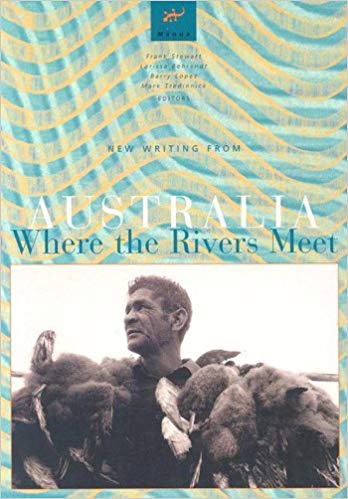
Ashley Hay wrote about the city of Wollongong, south of Sydney, built between the coastal mountains and the ocean and necessarily spreading north and south but never east or west. The whole city is ‘on the edge’ of Australia. She remembered being taken for a drive, as a teenager, along the road that once precariously hugged the steep cliffs prone to rockfalls, and compared it with the bridge that has replaced that road, the SeaCliff Bridge, a cantilevered serpentine bridge that follows the same coastline but in an open space over the ocean.
I tried to imagine it. I looked at the photos online, but I wanted to feel it, to see it.
Today, I’m in Wollongong, and am being driven to the bridge. It’s pouring, a deluge of rain that began at 5am and hasn’t stopped since. We’re on the bridge, three tourists in brightly coloured raincoats are taking photos of each other joyously holding their arms out as the rain beats down. Not another soul can be seen, and barely another car. I’m not as bold as the tourists, I can’t get out and walk in this weather, so we continue along the road up to Bald Hill Lookout where the cloud is low and the wind is gusting and whoomping the car. The view is supposed to look as it does in this advertisement for the new seats by Outdoor Design :
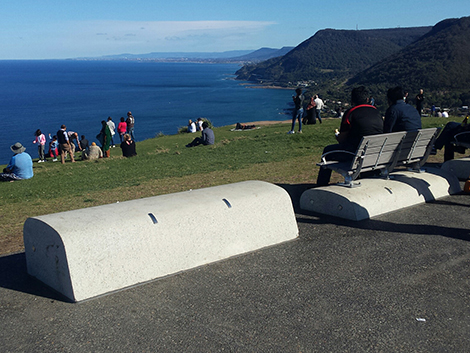
But today the view looks like this:

The sea is invisible, can’t open the windows, no point staying. We turn back towards the bridge and search for a place to stop so I can get out, stand still, and take in the view of this bridge I have only known in a story. The car parks are some distance away but I want to see what it’s like to walk on the bridge. I’ll need to take a photo and won’t be able to hold my umbrella steady in this wind, let alone a camera. It’s too hard, I give up and take a happy snap through the windscreen of our moving car.
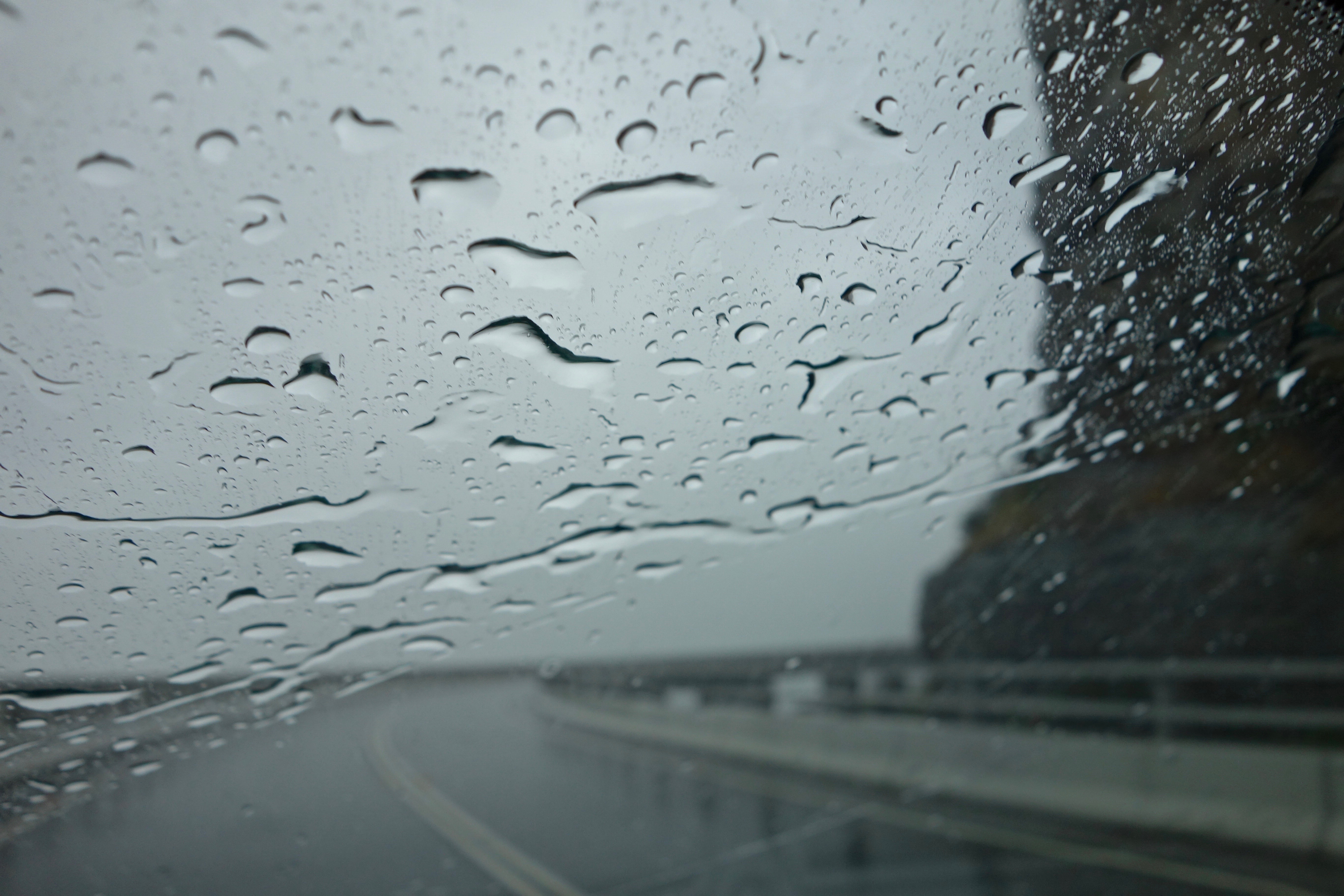
The view was so blurred by the torrents of rain that if I hadn’t seen photos of the SeaCliff Bridge I still wouldn’t know what it looked like. So what have I gained by wanting to get inside someone else’s story?
Perhaps tomorrow will not be a rainy day.
*
It’s because of the advent of digitised records – birth, death, marriage and war service records – and family tree web sites, particularly Ancestry, that I know now what I didn’t know a short time ago. I’d heard about my father’s time in Egypt as a WW2 soldier and I’d heard about his own father’s time in France as a WW1 soldier.
But I’d never heard of the family members who were killed in action.
My grandmother had two cousins, the Burley brothers, James and Frederick, who were killed in Northern France.
Can you imagine losing two sons who voluntarily went to war?
Now imagine losing three sons.
My grandfather had three cousins, the Shaw brothers, George, D’arcey and Frank, who were also killed in Northern France.
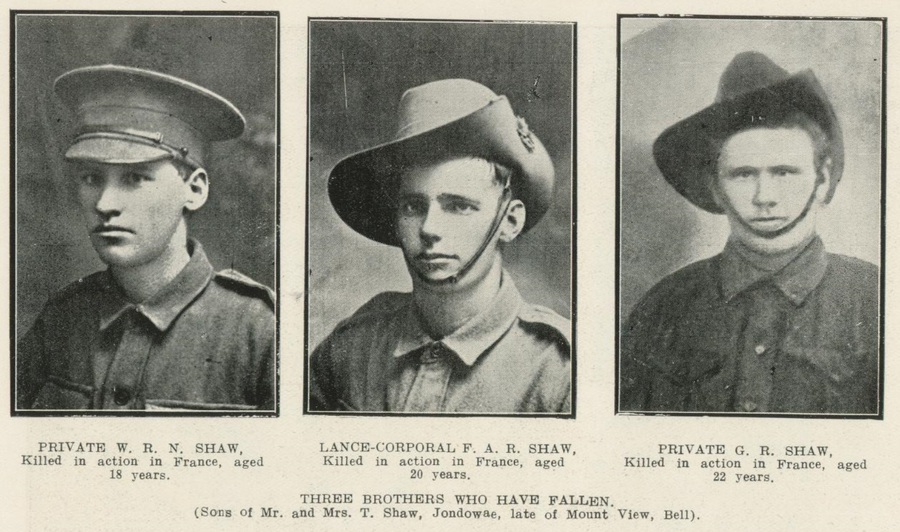
But because their cousin, my grandfather Ernest Bruce, survived gassing and a concrete wall falling on top of him, he returned to Australia to produce my father, who in turn produced me.
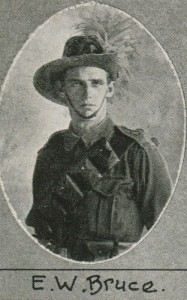
I’ve discovered most of this information through online records and family history websites. Many many family historians are using these resources now. This means that the great numbers of people commemorating the centenary of the armistice today, 11th November 2018, have learnt, like me, that they are the descendants of the ones who returned.
I have three sons. I feel absolute anguish for the parents who lost two or three of their children in war.
And I now have a greater appreciation of the struggles of Australians trying to build our nation a hundred years ago when the total population was 5 million, and 62,000 of their young people had been killed, and 156,000 were wounded, and many like my grandfather were unable to work again.
This building in the photo below, the Australian War Memorial, is ten minutes from my home. I’ve visited it countless times, and in the past few weeks as the crocheted and knitted poppies were displayed, and as I’ve read and heard so many stories from descendants of soldiers like me, I realise how fortunate I am that I have a comfortable home, enough food to keep me healthy, and a family that is gainfully employed. And I realise that WW1 was not the war to end all wars, there have been many wars since then, and I must not take my fortune for granted.
This new knowledge is greatly due to the digitisation of historical records, a technology I’m very grateful for.
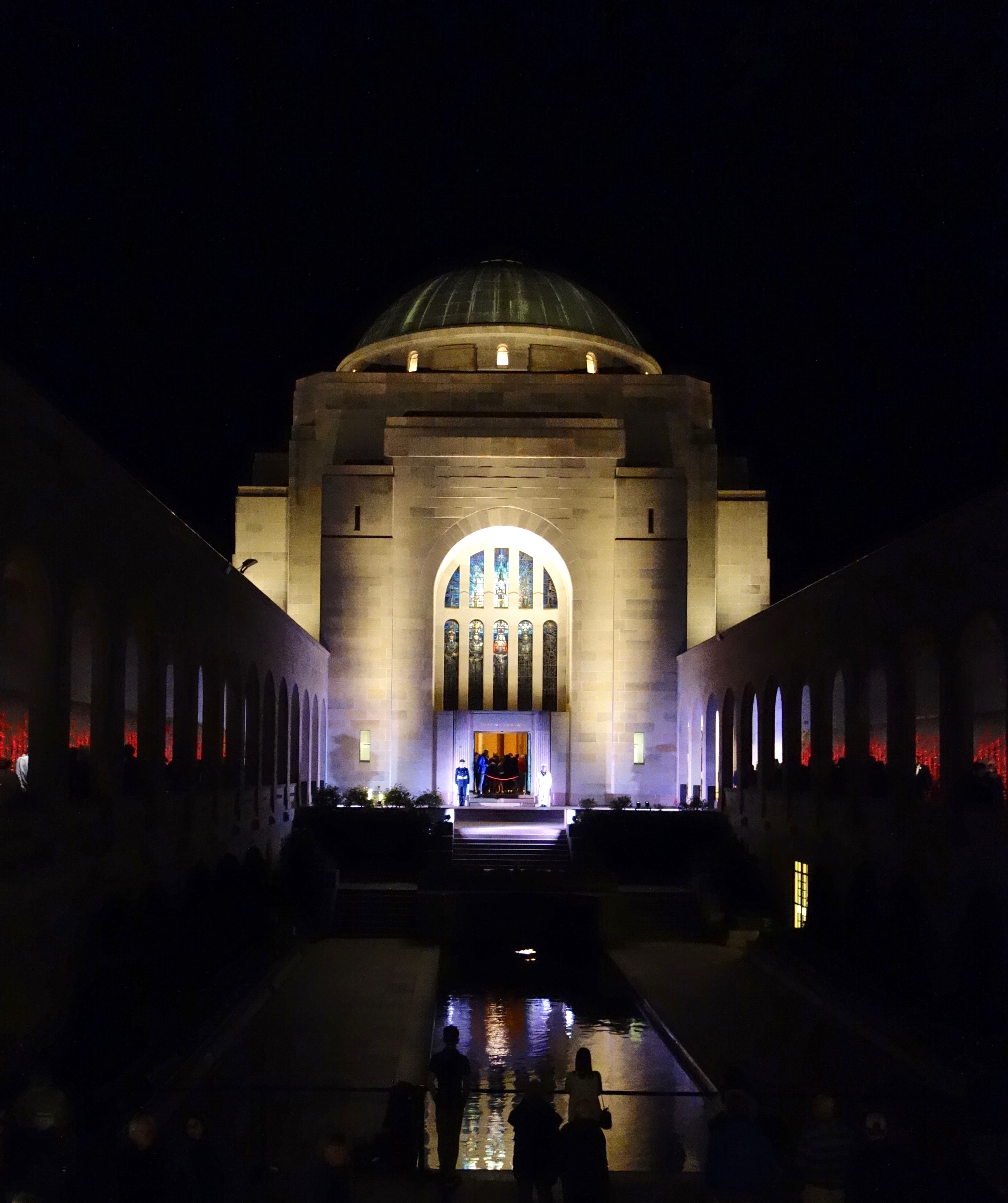
*